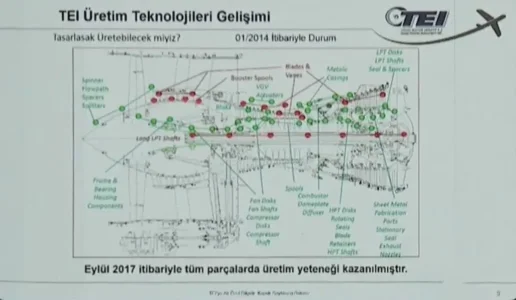First test firings of goksur air defense system which will be used as close air defense system.
When you look closely,it has foldable tail fins
View: https://twitter.com/T_Nblty/status/1891452812766105722?t=WVmc1FSG_vrX9ANrdhOhgA&s=19
ASELSAN GÖKSUR CIWS: A Cutting-Edge Naval Defense Solution
The
GÖKSUR Close-In Weapon System (CIWS), developed by ASELSAN, represents the latest in naval defense technology, offering critical protection against various modern maritime threats. This system is designed to be the last line of defense for naval vessels, providing rapid, precise firepower to neutralize incoming threats such as anti-ship missiles, fast-moving surface crafts, helicopters, and unmanned aerial vehicles (UAVs). The GÖKSUR CIWS is an essential component for modern naval fleets, delivering enhanced survivability in increasingly complex battlefields.
Key Features of GÖKSUR CIWS
Stabilized Gun Turret : One of the standout features of the GÖKSUR CIWS is its highly stabilized gun turret. Stability is crucial for maintaining precision in naval combat, particularly when ships are in motion or in rough sea conditions. This stabilization ensures that the system can accurately engage fast-moving targets even under challenging environmental conditions. The stabilization technology allows the gun to remain focused on the target, minimizing the chance of missed shots and maximizing the system’s effectiveness.
Dual Ammunition Capability : GÖKSUR offers a unique advantage with its ability to switch between two types of ammunition:
High-Explosive Incendiary (HEI) and
Airburst Ammunition (ATOM). The HEI rounds are highly effective against lightly armored aerial threats and fast-moving surface vessels, while the ATOM rounds are designed to explode in proximity to the target, enhancing lethality against small, hard-to-hit objects like UAVs and incoming missiles. This dual capability allows the system to adapt to the specific threat it faces, significantly increasing the chances of neutralizing the threat before it causes damage.
Automatic Target Tracking and Engagement : GÖKSUR is equipped with advanced target tracking and engagement capabilities. The system integrates
radar and
electro-optical sensors that provide real-time data on incoming threats. Once a target is detected, GÖKSUR can autonomously track and engage it without human intervention. This autonomy is crucial for a CIWS, as threats in modern naval warfare—such as missiles can travel at extremely high speeds, leaving little time for manual responses. The automated operation ensures that the system reacts swiftly, engaging threats in seconds.
3D Search Radar (Optional Feature) : For enhanced situational awareness, GÖKSUR can be optionally equipped with a
3D search radar. This radar provides detailed data on the surrounding airspace and surface, allowing for more accurate detection and tracking of potential threats. The 3D radar is especially useful in environments where multiple threats may approach simultaneously from different directions. By providing early warning and accurate target data, the radar enhances GÖKSUR’s ability to intercept and neutralize incoming projectiles or hostile crafts.
Fully Autonomous Operation : GÖKSUR operates with minimal human input, making it highly reliable in combat situations. Once the system is armed and set to automatic mode, it can independently detect, track, and engage threats. The autonomy of the system reduces the risk of human error and ensures a faster response time, which is critical when dealing with high-speed threats like anti-ship missiles. This feature makes GÖKSUR an indispensable part of the ship’s overall defense strategy, especially in situations where multiple threats are approaching simultaneously.
Integration with Combat Management Systems : Another major advantage of GÖKSUR is its seamless integration with a ship’s
Combat Management System (CMS). This integration allows GÖKSUR to work in conjunction with other onboard sensors, weapons, and defense systems to create a unified, coordinated response to incoming threats. By sharing data and working as part of a larger defense network, GÖKSUR ensures that a naval vessel’s defensive capabilities are maximized.
Versatility in Threat Engagement : GÖKSUR is capable of engaging a wide range of targets, making it one of the most versatile CIWS platforms available. It is particularly effective against:
- Anti-ship missiles : The primary threat that GÖKSUR is designed to neutralize, given their speed and destructive power.
- Helicopters and Fighters : The system’s tracking and engagement capabilities make it effective against low-flying aircraft.
- UAVs : With the rise of drones in modern warfare, GÖKSUR’s ability to engage small, fast-moving aerial targets is a significant advantage.
- Asymmetric Surface Naval Threats : This includes fast boats or other small, agile crafts that might pose a danger to larger naval vessels.
Advantages of GÖKSUR CIWS
Enhanced Flexibility and Adaptability : GÖKSUR’s ability to switch between HEI and ATOM ammunition, combined with its broad range of target types, makes it highly adaptable to various combat scenarios. This flexibility ensures that naval forces can rely on GÖKSUR to effectively counter multiple types of threats, from missiles to drones to surface boats.
Reliability in Autonomous Defense : One of the most important aspects of any CIWS is its reliability under pressure. GÖKSUR’s autonomous operation, combined with its fast response time, ensures that it can reliably protect ships even when human operators are overwhelmed or in high-stress situations. The system’s fully autonomous mode eliminates the risk of delay in threat engagement, which can be critical when defending against fast-moving projectiles.
Integration with National Defense Infrastructure : As part of ASELSAN’s broader range of defense products, GÖKSUR is designed to be easily integrated with other defense systems produced by ASELSAN or used within allied defense networks. This ensures compatibility with other platforms and enhances overall mission readiness.
Cost-Effective Naval Defense Solution : ASELSAN has earned a reputation for producing high-quality, cost-effective defense systems, and GÖKSUR is no exception. The system offers cutting-edge technology at a competitive price point, making it an attractive option for countries seeking to enhance their naval defense capabilities without the cost of more expensive Western alternatives. Additionally, the system's modularity means that upgrades and modifications can be implemented over time without the need for complete replacement.
Scalability for Different Naval Platforms : GÖKSUR is designed to be scalable, allowing it to be deployed on a variety of platforms, from smaller patrol boats to larger frigates and destroyers. This scalability increases its utility across different types of naval forces, making it suitable for both blue-water and littoral operations.
ASELSAN’s GÖKSUR CIWS is a powerful and versatile defense system that offers a critical layer of protection for naval vessels against a variety of modern threats. With features like dual ammunition capability, autonomous operation, and seamless integration with combat management systems, GÖKSUR stands out as a highly effective and cost-efficient solution for navies worldwide. Its ability to engage a wide range of threats, combined with its advanced targeting and tracking technologies, ensures that GÖKSUR will play a key role in safeguarding naval assets in high-threat environments








